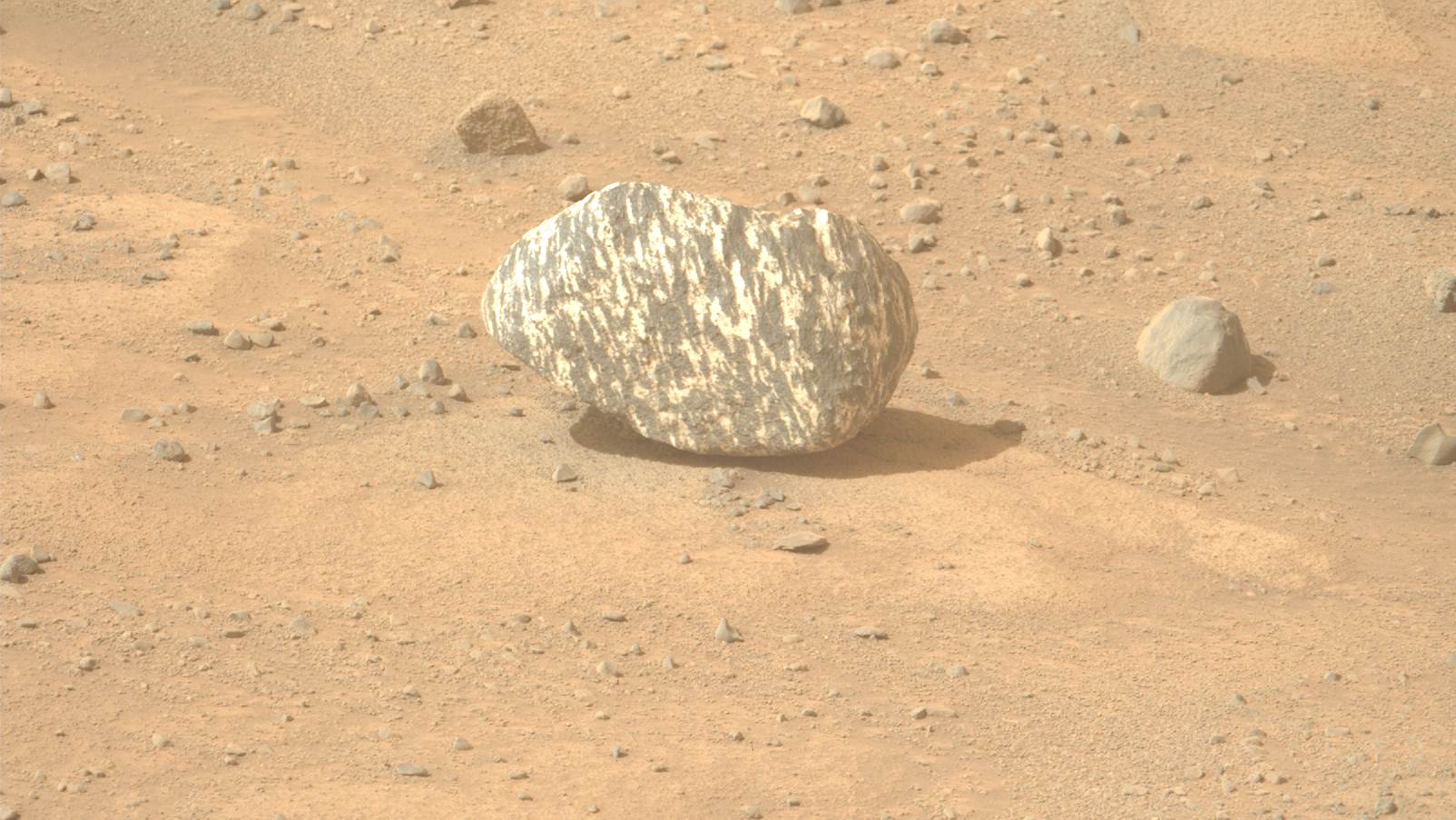Weird striped rock ‘unlike any seen on Mars’ found by Perseverance rover. Here’s why NASA’s excited

NASA Space Technology

A striped rock that looks out of place in its surroundings on the slopes of the inner wall of Jezero crater has scientists excited about what it may reveal about the Red Planet’s history.
NASA’s Perseverance Mars rover spotted the striped rock, and the rover’s initial measurements suggest it could be volcanic in origin. The rock, which has been nicknamed ‘Freya Castle,’ may originate from an outcropping of more of this strange material further up the slopes of Jezero.
Freya Castle looks quite unlike any rock seen on Mars before. But Perseverance could not stick around at Freya Castle to examine it for long before continuing its journey up the inner wall of the mighty Jezero crater, the interior of which the rover has been exploring since landing on Mars in February 2021.
Perseverance spotted the rock and imaged it while taking measurements with its Mastcam-Z instrument on Sept. 13, 2024 (sol 1,268 of the mission; a sol is a Martian day, which is 37 minutes longer than a day on Earth). Mastcam-Z serves as the primary “eyes” of Perseverance, providing high-resolution stereo and zoom capabilities.
Related: NASA’s Perseverance Mars rover finds possible signs of ancient Red Planet life
However, MastCam-Z’s multispectral observations of Freya Castle, which is just 7.9 inches (20cm) across, have already provided significant clues as to the rock’s origin.
“Our knowledge of its chemical composition is limited, but early interpretations are that igneous and/or metamorphic processes could have created its stripes,” wrote Athanasios Klidaras, who is a PhD student in planetary science at Purdue University, in a statement on NASA’s Science website.
While a volcanic or metamorphic (wherein one type of rock is transformed into another, usually under excess temperature and/or pressure) origin may explain its stripes, it doesn’t explain how Freya Castle arrived at where Perseverance found it, standing out like a sore thumb against all the other nondescript pebbles and rocks. One possibility is that it rolled down from an outcropping of similar rock higher up the slopes.
“The possibility has us excited, and we hope that as we continue to drive uphill, Perseverance will encounter an outcrop of this new rock type so that more detailed measurements can be acquired,” wrote Klidaras.
Finding strange rocks on the slope of the crater’s inner wall is not unexpected; mission scientists had been hoping for as much. So far they have not been disappointed.
Besides Freya Castle, in May 2024 Perseverance came across a boulder field nicknamed Mount Washburn. Most of the rocks appeared dark, typical of many other similar rocks found on Mars, but one rock in the middle of the boulder field was different.
Appearing bright with a speckled texture, the rock was nicknamed Atoko Point and measured 18 inches by 14 inches (45cm by 35 cm). Mastcam-Z and the rover’s SuperCam, which fires a laser at a target rock to vaporize some of its outer material so spectroscopic instruments in SuperCam can analyze its composition by studying the resulting plasma from a distance, learned that Atoko Point is composed of pyroxene and feldspar. Both materials are commonly found in volcanic and metamorphic rocks on Earth. Atoko Point also probably originated elsewhere further up-slope, and mission scientists expect to find many other odd rocks that have rolled down the Martian hills, perhaps after weathering off from large outcroppings.
The rock discoveries are coming as part of Perseverance’s fourth science campaign, which is primarily dedicated to searching for evidence of carbonate and olivine deposits in what mission scientists are referring to as the ‘Margin Unit’ — the big geological unit that forms the inner wall of the 28-mile-wide (45km) Jezero crater.
Carbonate rock such as limestone should have formed in Mars’ ancient past when it was warmer and wetter, but so far carbonate rocks have been few and far between in our exploration of the Red Planet. Olivine is a more common mineral on Mars, and is associated with water on the surface in the past. By climbing up the crater walls, the hope is that Perseverance will chance upon outcroppings of these precious rock types that have been unearthed in the mighty impact that formed Jezero 3 to 3.7 billion years ago.
Join our Space Forums to keep talking space on the latest missions, night sky and more! And if you have a news tip, correction or comment, let us know at: [email protected].
Discover more from Tamfis Nigeria Lmited
Subscribe to get the latest posts sent to your email.



 Hot Deals
Hot Deals Shopfinish
Shopfinish Shop
Shop Appliances
Appliances Babies & Kids
Babies & Kids Best Selling
Best Selling Books
Books Consumer Electronics
Consumer Electronics Furniture
Furniture Home & Kitchen
Home & Kitchen Jewelry
Jewelry Luxury & Beauty
Luxury & Beauty Shoes
Shoes Training & Certifications
Training & Certifications Wears & Clothings
Wears & Clothings
















